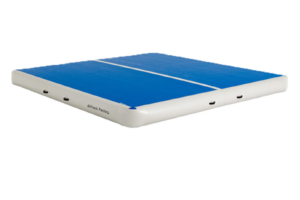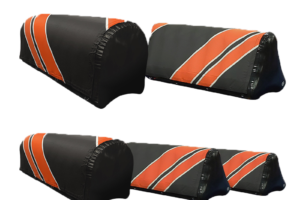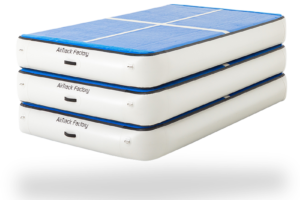What is the difference between parkour and freerunning?
The art of freerunning is expressing oneself in the environment. Hence a freerunner. Parkour is a training discipline that uses movements developed from one obstacle to the next. It usually happens where there are large structures or buildings in the city.

The Biggest Difference between parkour and free running:

Parkour:
- founded in France in 1998
- practitioners are traceurs
- disciplined
- competitive & non-competitive
- urban areas
- uses obstacles to get from point A to point B
Freerunning:
- founded in the UK in 2003
- practitioners are freerunners
- expressive
- non-competitive
- urban and natural area
- continuous running through obstacles
What is parkour?

Since the creation of Parkour in the late 1980s, Parkour has been gaining recognition worldwide. The new sport is a natural fit within several nation Gymnastics federations to offer Parkour programs and classes. In 2018, launched the first World Cup series within the World Actions Sports Festival as the biggest Parkour competition.
History of Parkour
The Parkour adventure began in France in the 1990s, in Lisses and Evry, in the outskirts of Paris. David Bell and his friends from the Yamakasi group practiced jumping and climbing over normal everyday objects like stairs, barriers, walls, and other structures in the city. For them as teenagers, this type of training method helped them to overcome all forms of obstacles in the urban jungle as well as in natural environments like the forests. He was greatly inspired by his father Raymond Belle who was a Parisian firefighter. His father was one of the most capable recruits by smashing virtually every record they had for the obstacle course and then doubling down by winning several fire-fighting competitions, particularly being adept at rope climbing.
Raymond would test himself by devising his own obstacle course using natural objects to be the quickest as possible. He would train countless hours on practicing speed, in silence, and daring heights without injury. Raymond also learned from Georges Hébert, a famed physical education expert who also happened to be the original inventor of the military obstacle courses Raymond had used to hone his body and skills in his youth. Hébert’s training method consisted of a series of 10 basic exercises that were essentially good for overall physical fitness. Over the years the fitness regime Herbert developed, known as “The Natural Method”, grew to ten fundamental groups to include walking, running, jumping quadrupedal movement, climbing, balancing, throwing, lifting, self-defense, and swimming. It also included training in courage and morality.
Parkour Now
To watch parkour, many see an influence of martial arts and think of Bruce Lee and Jackie Chan. David Belle did spend 3 months studying in India kung fu. The philosophy of parkour is similar to martial arts but parkour is non-combative. The physical movement may be important and impressive to see but according to David Belle’s 2009 book “Parkour”, a traceur’s understanding of its principles, values, and the mental view is the most important aspect. Belle also describes parkour “as an art that requires huge amounts of repetition and practice to master.” It is a discipline.
The Philosophy Behind Parkour
The movements of parkour are probably as old as the human form itself. At its most basic level, parkour is simply a string of efficient and athletic movements that have been practiced, in one form or another, by athletes, warriors, monks, and entertainers stretching back millennia. Hébert, who could be called the grandfather of parkour, based his exercise philosophy on indigenous tribes he observed in Africa.
Parkour traditionalists stress the importance of physical self-reliance and freedom of movement as well as overcoming both physical and mental barriers. Personal growth is paramount. David Belle sees it as a training fit for warriors and emphasizes mastering control and focus so as to be able to perform with force and precision. Competition is frowned upon, with some adherents saying that the inclusion of any competitive elements strips the movements of the parkour label.
Parkour Moves
Tic Tacs
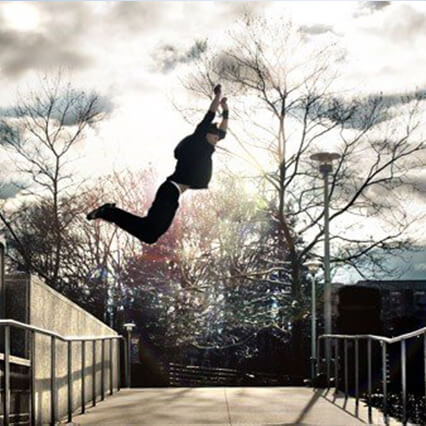
The “tic tac” is a great parkour move to start out with. This energetic move will have you up in the air in no time. Make sure your Tower Wedge is propped against a firm wall, on the tallest setting with the larger base of the wedge on the ground. This will create a roughly 45 degree angle. Start with your chest facing the wedge, about two large steps away from the base. Advance quickly to the wedge with power, leaping into the air on your second step. As you kick up towards the sky, spin towards your right or left side, using the wedge as a powerful base to pivot off of.
Cat Leap
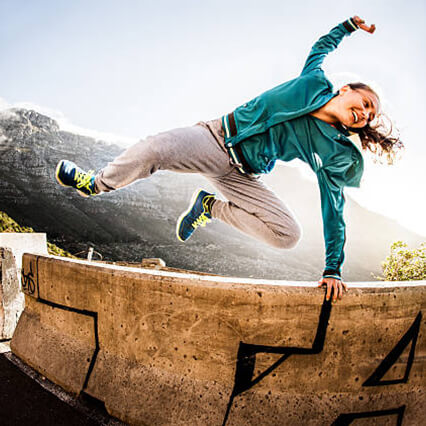
The Cat Leap is a classic parkour movement used to climb over walls. Cat Leaps can be combined with other moves to create an impressive series of steps across any urban landscape with a little height. Start by positioning the tower wedge on a vertical setting with the wider base on the floor, and the peak tilting away from you. Stand about 4 leaps away from the wedge, with your chest facing the wedge. Run towards the tower wedge and once you are about one step away from the base, leap into the air, extending both hands into the air. The aim is to reach for the top of the wall, but to allow the feet and legs to use the power of the wall to propel you upwards.
Wall Flips
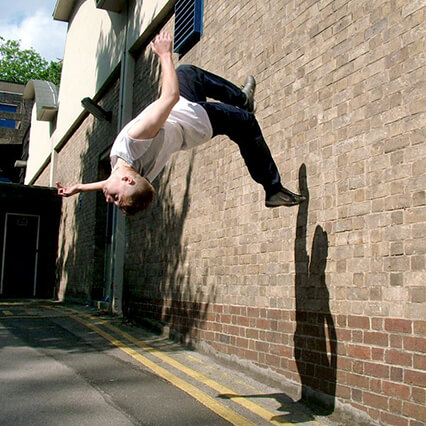

Before you try doing a wall flip, it’s important to know some basic flip moves in order to have a foundational knowledge and comfort in the movements your body needs to do to execute a wall flip. Some of these foundational prerequisite moves include a standing back tuck, a back handspring, a front flip, and even a side flip. This will be your power foot. As you spring off of the block and into your tuck, keep your back and upper body flexed- do not arch backwards.
Climb up / Muscle Up


Place your hands on the top of the wall or edge of a block about shoulder width apart. In one swift move, engage the core and bring your feet up onto the top of the wall or edge of a block in a staggered, sprinting position. This is the first part of the climb. To advance up the wall drive your lower leg upwards. Here, the power is coming from the legs and core- not just the arms and shoulders.
Our AirBox is the perfect use for these basic moves. You can punch off of it to get more air or use them for obstacles when doing moves like the cat leap or tic tacs. Our main products of our Parkour AirBlocks were made in the request for those wanting a challenge and to use something new at trampoline parks.
What is freerunning (also known as free-running)?
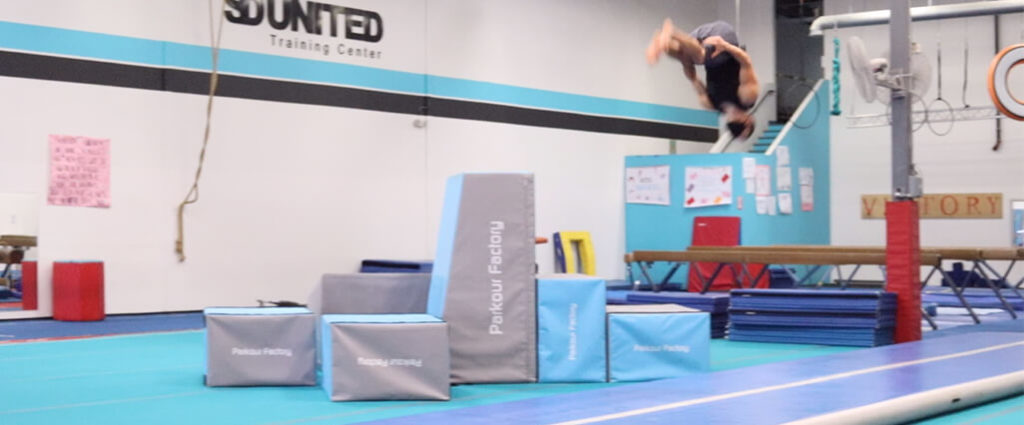

Freerunning is base is expressing oneself while running. While parkour is trying to get to point a to b. Freerunners will take their time and do it with style, they are still jumping over obstacles but not contained to the urban jungle.
History of Freerunning
Sébastien Foucan became the subject of some documentaries in the United Kingdom in the early 2000s. The word “freerunning” was coined during the filming of the documentary “Jump London”. Then in 2006, Foucan starred in the opening chase scene of the James Bond film, “Casino Royale”. This exposure brought parkour and freerunning out of its niche to the world stage.
There are differences though between parkour and freerunning. According to Foucan’s website, Foucan was dissatisfied with parkour’s limited creativity and self-expression. This led him to create freerunning. Though similar in movements, freerunning is about innovation and expression. Parkour differs in that there is more speed and efficiency in getting from point A to point B. Belle and others have been critical in Foucan and freerunning. Worldwildjam. tv says that freerunning is a mix of parkour techniques and acrobatics to serve and impress people.
David Belle attempted to trademark “Parkour” but was not successful. Therefore, many people and companies have used the name likening it to words such as “baseball”, or “soccer”. With the rise in popularity, many wanted competitions in parkour. This goes against the very philosophy of what Belle believes parkour is about. Parkour is not a sport. Competition is rivalry for supremacy whereas parkour is about teamwork, equality, and self-development. Parkour is a holistic training discipline, not just the physical aspect. Freerunning on the other hand does not have these boundaries and one can find competitions everywhere. And because it is so closely related to parkour, and without the trademark, one can find “Parkour and Freerunning Competition” together all around the world. Either way, both disciplines require constant practice and team effort to succeed.
A super-soldier like Cap would naturally be adept at parkour, and he makes great use of the discipline in almost all his action scenes, whether he is dodging in and out of view on a ship full of terrorists or chasing after the Winter Soldier through building, across rooftops, and over bridges.
A freerunning athlete is forced to compete in a parkour tournament created by a group of bloodthirsty businessmen who are looking for a new and more exciting form of gambling where actual human lives are at stake. Failure to win the race means the bomb attached to your neck detonates. The premise of the movie is rather forced, but once you get to roll with it, you can focus on what this movie truly is: a comprehensive showcase for all the ways in which parkour techniques can be used to clear obstacles, performed by some of the best athletes in the field.
The Philosophy Behind Freerunning
Style and theatrics are an important part of freerunning. For instance, while a traucer would simply vault over a wall as fluidly and quickly as possible, a freerunner might flip off the wall. The point is not to move as quickly as possible, but to be creative, improvise and express oneself. Philosophy plays and even more important role in parkour than in freerunning. In fact, many of the most prominent athletes in parkour have clarified that parkour is not a sport, but an art, or a discipline. There is an intense focus on the self, on merging mind and body, and being able to overcome physical and mental obstacles. Belle has described parkour as a means of self refinement and improving physical and mental control. An emerging philosophy of parkour is that of human reclamation, or moving naturally through an environment in a way that has been lost in civilization. The idea is to interact with and use the physical world, rather than simply be directed by it.
Freerunning Moves
Running, Jumping, and Landing
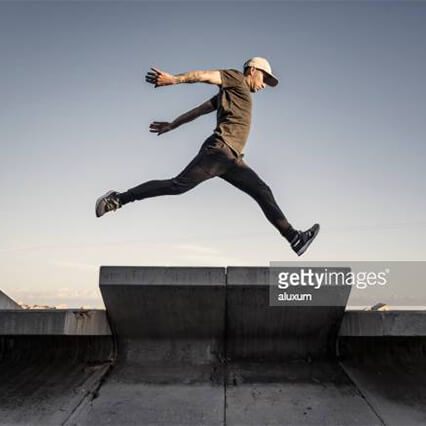
You need to develop a good basic stamina and strength. Running, jumping, and landing are the most important and basic moves you can do in starting freerunning. Practice doing drills of these three in a park or at home. When you land you’d want to do a tucking roll by tucking in your head into your body and roll on your back. You might recall this landing move as a ninja roll when you see Youtube videos when freerunnings jump and land into it.
Jumping Over

When jumping over things, there are two aspects to it – jumping vertically to clear a tall object, and jumping horizontally to clear a large or long object – and many jumps will involve some of each. Take a small run up to an object and leap completely over it without slowing down or touching it, leading with one foot and lifting both legs to clear it, and continue running after landing.
Swing Through
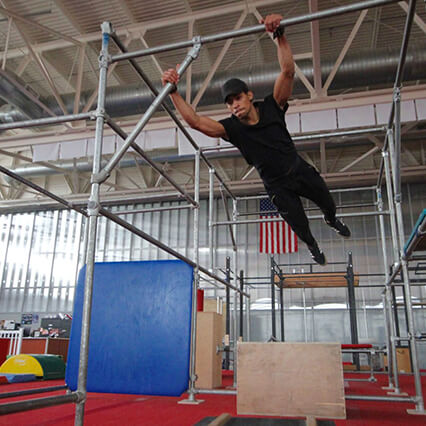

To practice and gain the strength to properly execute it, begin by running up to a bar (playgrounds are awesome for that), jump for the bar with your hands, and swing your body underneath you, letting go of your hands to land away from the bar. Once you can catch the bar and swing under it confidently, mark out an area beyond the bar to land in, as if you’re hitting a target, and as you jump, lift up your legs and curl your body, pretending that you’re going through a smaller opening.
Vaulting
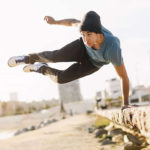
Being able to clear fences or walls or other obstacles with just a single touch of the hands is a pretty cool looking move, but it isn’t as hard as it might seem. At the basic level, a vault involves making a leap with your body up and to one side (not straight over, as in the previous example), using your hands to direct and propel your body over the object.
Our Airtrick was made for those who want to try out their skills, practice them, or hone in new ones. The AirTrick is thick and wide enough for practice your freerunning or tricking skills.

 408-569-9504
408-569-9504



